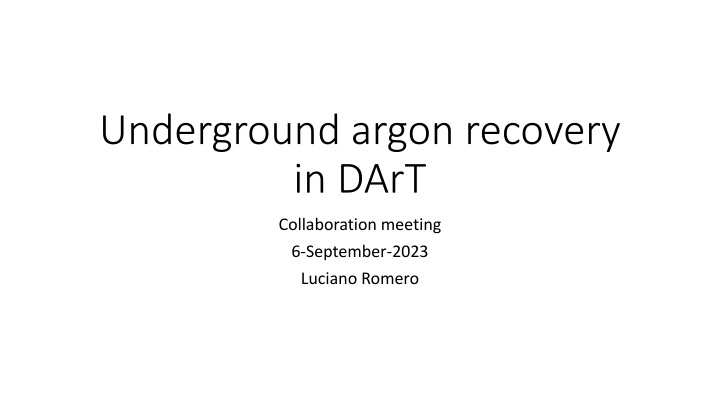Argon Recovery and Measurement in DArT Collaboration Meeting Overview
This document discusses the process of measuring and recovering underground argon in the context of a DArT Collaboration Meeting. It includes information about the underground argon in LSC, the DArT gas system presentation, the procedure to empty DArT, hardware issues related to the connection to gas bottles, and the argon recovery cylinder system. The content details steps, equipment, and safety considerations involved in the process.
Download Presentation

Please find below an Image/Link to download the presentation.
The content on the website is provided AS IS for your information and personal use only. It may not be sold, licensed, or shared on other websites without obtaining consent from the author.If you encounter any issues during the download, it is possible that the publisher has removed the file from their server.
You are allowed to download the files provided on this website for personal or commercial use, subject to the condition that they are used lawfully. All files are the property of their respective owners.
The content on the website is provided AS IS for your information and personal use only. It may not be sold, licensed, or shared on other websites without obtaining consent from the author.
E N D
Presentation Transcript
Underground argon recovery in DArT Collaboration meeting 6-September-2023 Luciano Romero
Underground argon in LSC Recently arrived from LNGS to LSC 3x50 liters bottles with compressed (20 bar) underground argon 1.25 liters of LAr in each bottle (50x20/800) Enough to fill DArT (1.1 liters) We want to measure this argon in DArT-Test After measurement it s desirable to recover this valuable underground argon We can use the received bottles We should check if this bottles have a no refill valve We can use the definitive gas system rack of DArT We get experience using the gas system The DArT slow control can start to work
DArT gas system Presentation 21-Apr-2021
Procedure to empty DArT Start conditions: LAr in normal TP conditions, DArT isolated (V16, V17 closed) Apply vacuum to the gas system except DArT (open V14, V12, V1, V2) Fill the cryostat of the Ar condenser with LN2 Close V14. Open V17. Start controlling manually the flow out from DArT Reach the triple point pressure in DArT (0.7 bar). Mantain the pressure by adjusting the flow Wait to empty DArT. This happens when the flow vanish when trying to mantain the pressure. Let DArT pressure go down to vapor pressure at LN2 temperature DArT is empty. Close V1, V17 Open the recover bottle V15. Let the Ar condenser to warm up
Hardware issues. Connection to gas bottle The connection to the gas bottle is composed of 4 items: Adaptor from bottle connector to NPTM Adaptor from NPTF to VCRF (Swagelok SS-8-VCR-7-4) Adaptor from VCRM to VCRM (SS-8-VCR-6-DM) Flexible hose , 80cm, from VCRF to VCRF (SS-FX8RF8RF8-80CM) All this items should be at LSC for Spain bottle connector (type C) Bottles come with an Italian connector An adaptor to NPTM should be supplied The system is designed for B10 bottle The argon is in B50 bottles We should check that the hose reach the top of the bottle There is a safety concern about tying the B50 bottle to the gas rack Currently it is allowed to tie it to the ArDM structure
Hardware issues. Argon recovery cylinder Initially the system was designed to use an available CRYOFAB 9518 as the recovery cylinder cryostat (V1) This cryostat is currently used in the test setup A replacement cryostat was bought to replace the 9518 (V1.5) My feeling is that this cryostat is too big and clumsy to be use for argon recovering No room within the gas rack Another option is to use thermal insulation instead of a cryostat (V2) This option is less efficient than the cryostat but is more compact More LN2 compsumtion More condensation But the recovery of argon is done sparsely Several hours every 2 weeks
Hardware issues. Argon recovery bottle V1.5 V2 V1
Hardware issues. Argon recovery bottle Versions V1.5 and V2 are ready at CIEMAT A new version (V3) can be build in the CIEMAT workshop in a reasonable short term All materials are available This version can be anchored with bolts to the gas rack Increasing the safety rating Increase the surface of the condensing bottle exposed to LN2 V3
Hardware issues. Connection to the argon recovery bottle In the base design the recovery bottle is connected to the gas system by inox pipe and Swagelok connectors (VCR and racords) An option is to substitute this rigid piping by a flexible hose





















